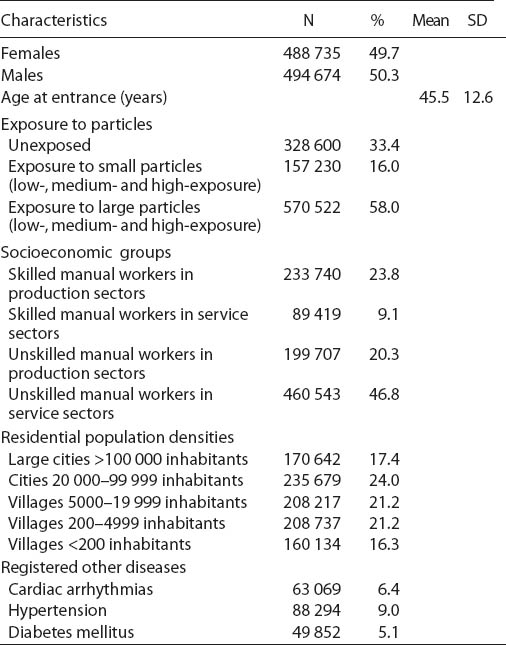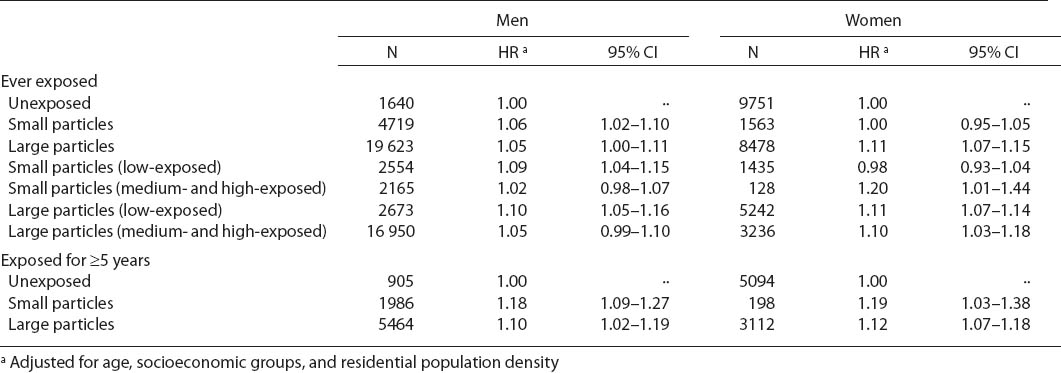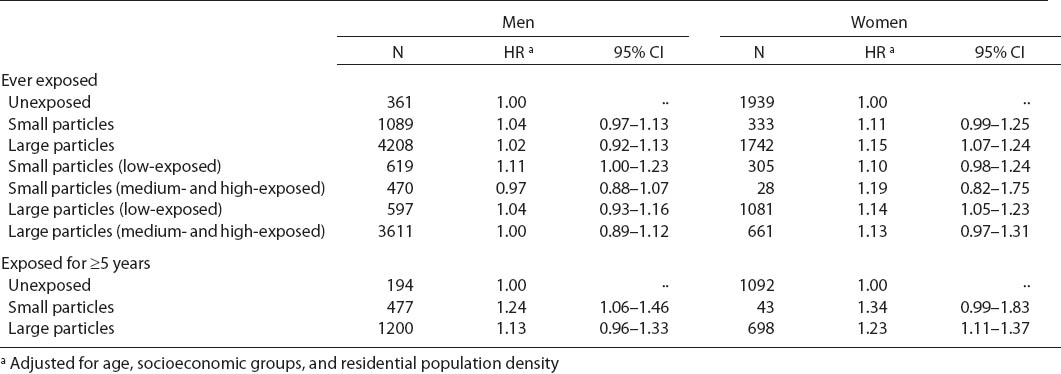Stroke is a term that signifies the abrupt impairment of brain function caused by a variety of changes involving one or several cerebral blood vessels. The annual estimated number of first-ever stroke in Sweden is around 30 000 and the mean age is around 73 years for men and 77 years for women (1). Between 1989–2000, the incidence of stroke increased by 19% and 33% among men and women, respectively. The largest increase was observed among those <60 years (2). Stroke is the third most common cause of death in Sweden (1), and stroke mortality appears to decline (2).
Approximately 85% of all strokes are caused by diminished blood flow (ischemic stroke) and the remaining 15% include hemorrhage into the brain tissue and the surrounding subarachnoid space. Hypertension, smoking, diabetes, and atrial fibrillation are well-established risk factors for stroke (3).
Particulate urban air pollutants have been associated with stroke in some investigations (4–6). Some studies have also observed an increased risk of cerebrovascular disease among potentially particle-exposed workers such as building and construction workers, chimney sweeps (7), aluminum potroom workers (8), and army cooks (9), but other studies have not revealed such associations (10).
This study is a part of the PARticles and Cardio- and Cerebrovascular diseases (PARCC) project. The aim of the present study was to investigate the association between occupational exposure to particles, particle size, and the incidence of stroke among women and men.
Methods
Study base
The cohort comprises all manual workers in the Swedish National Census in 1980, who were alive as of 1 January 1987, in total 984 040 men and 741 631 women. The cohort was restricted to manual workers, including skilled and unskilled manual workers in the production and service sectors, in order to limit potential confounding from smoking and other lifestyle factors. Thus, white-collar workers, professionals, self-employed, and farmers were not included. First time events of ischemic stroke or cerebral infarction [International Classification of Diseases, 9th Revision (ICD-9) code 434 or 10th Revision (ICD-10) code I63] and hemorrhagic stroke (ICD-9 code 431 or ICD-10 code I61) during the period 1987–2005 were identified through linkage to the nationwide Hospital Discharge Register and the National Cause of Death Register. Only first-time events of cerebral infarction or hemorrhagic stroke were considered in the respective analysis. We also recorded diagnoses of cardiac arrhythmias (ICD-9 code 427 or ICD-10 code I47–I49), hypertension (ICD-9 code 401–405 or ICD-10 code I10–I15), and diabetes mellitus (ICD-9 code 250 or ICD-10 code E10–E14) for later scrutinizing groups with increased susceptibility of developing stroke.
The Regional Ethical Review Board in Stockholm, Sweden, approved the study.
Exposure assessment
Information on occupation, socioeconomic status, and residential population density was obtained from the population censuses in 1980, 1985, and 1990. The censuses provide occupational codes according to the Nordic adaption of the International Standard Classification of Occupations [Nordisk yrkesklassificering (Nordic Occupational Classification) 1978] (11). A job-exposure matrix (PARCC-JEM) was developed by experienced occupational hygienists by combining relevant occupational particle exposure information from a Swedish JEM developed for the Nordic Occupational Cancer Study (NOCCA) (12) and an airway irritant-JEM (13). The estimated levels in the PARCC-JEM are based on exposure measurements from Sweden when available and otherwise from other Nordic countries. Twelve groups of particle exposure were used from the NOCCA-JEM and seven from the airway irritant-JEM. Together these 19 groups of particle exposure covered the occupational particle exposure of interest, except for cooking fumes. We therefore assessed exposure to cooking fumes in all occupations in the JEM. The PARCC-JEM thus includes 20 groups of particle exposure and about 300 occupations (13). Each cell of the JEM shows the proportion of exposed workers and the exposure level (air concentration) for each particle group. The JEM is time-specific and covers two time periods: 1975–1984 and 1985–1994.
Exposure levels were assessed using a semi-quantitative scale with four categories, expressed as proportions of the Swedish occupational exposure limits (Swedish Work Environment Authority Regulations) (14) <1/30 (no exposure), 1/30–1/10 (low exposure level), 1/10–1/3 (medium exposure level) and >1/3 (high exposure level). To achieve as great a contrast in exposure as possible between exposed and unexposed workers, we defined an occupation as exposed only if there was a high prevalence of particle exposure (≥80% exposed in the occupation). To investigate the influence of particle size, the particle exposures in the JEM were classified as small or large particle size (<1 µm and >1 µm, respectively). Subjects in particle-exposed occupations with an exposure prevalence <80% were excluded from the analyses.
The PARCC-JEM included 104 occupations with particle exposure, but only 31 occupations were associated with medium- and high-particle exposure and a high prevalence (≥80%). In 50 occupations, no exposure assessment was feasible, mostly due to undefined working tasks or heterogeneous group of tasks with different exposures. Unexposed occupations were defined as occupations without exposure to any of the particles in the JEM, totaling 128 occupations. In total, 494 674 men and 488 735 women were included in the analyses for ischemic stroke, and 494 737 men, and 488 769 women were included in the analyses for hemorrhagic stroke. Ischemic stroke cases diagnosed prior to the start of follow-up were excluded from analysis of ischemic stroke, and hemorrhagic stroke cases diagnosed prior to start of follow-up were excluded from analysis of hemorrhagic stroke.
Statistical analysis
Subjects were considered to be under risk from 1 January 1987 until first episode of ischemic or hemorrhagic stroke, death, emigration, or 31 December 2005, whichever occurred first. In case of immigration of a formerly emigrated person in the study base, the person contributed with person-years from the immigration date until any of the events mentioned above occurred.
Exposure status was determined from the 1980 census and was updated according to the 1985 and 1990 censuses if exposure status had changed. The association between particle exposure and the outcome was estimated through Cox proportional hazards modeling. Hazard ratios (HR) for men and women are presented with 95% confidence intervals (95% CI). All risk estimates were adjusted for age (continuous variable), socioeconomic group (4 categories: skilled or unskilled manual workers in production or service sectors, respectively) and residential population density (5 categories based on population density: <200, 200–4999, 5000–19 999, 20 000–99 999, and ≥100 000 inhabitants) as a proxy for environmental air pollution. When the outcome of exposure to small particles was studied, the calculations were adjusted for exposure to large particles and vice versa.
To assess the effect of exposure duration, we restricted one analysis to subjects with exposure to particles in at least two consecutive censuses, which are five years apart (ie, subjects who had the same occupational code, exposure status, and socioeconomic position in at least two consecutive censuses in 1980, 1985, and 1990). The corresponding restrictions were also applied to the unexposed subjects.
A subject may be unexposed and belong to the unexposed group for some period of time and later become exposed and consequently belong to an exposed group for the rest of the follow-up period. Subjects may be occupationally exposed to several agents and may, therefore, have been exposed to both large and small particles.
Results
In total, the cohorts comprised 983 409 and 983 506 participants for ischemic stroke and hemorrhagic stroke, respectively. Detailed characteristics of the cohort used for analyzing ischemic stroke are described in table 1. The characteristics of the cohort used for analyzing hemorrhagic stroke were similar and are not presented.
Table 1
Characteristics of the cohort studying ischemic stroke comprising 983 409 participants. [SD=standard deviation.]

During the follow up period 1987–2005, 43 080 first-time events of ischemic stroke were registered, of which 23 437 occurred among men. The total number of registered hemorrhagic strokes was 9070, 5092 of which occurred among men.
Women and men exposed to small or large particles for ≥5 years showed an increased risk of ischemic stroke, after adjusting for age, socioeconomic status, and residential population density (table 2). HR for “ever exposed” to small or large particles were slightly lower. The crude HR (without adjustment for socioeconomic status and residential population density) were slightly lower for men exposed to small particles (HR 1.04, 95% CI 1.01–1.08) and large particles (HR 0.97, 95% CI 0.94–1.01) (data not shown). The crude estimates were almost the same as the adjusted for women exposed to small particles (1.00, 95% CI 0.95–1.05) and large particles (1.11, 95% CI 1.08–1.14). Workers exposed at two consecutive censuses, five years apart, had higher HR than “ever exposed” workers. There were no signs of a positive trend with exposure intensity, comparing HR among the low-exposed with the medium- and high-exposed, neither among men nor women exposed to small or large particles.
Table 2
Exposed and unexposed cases (N), hazard ratios (HR) and 95% confidence intervals (95% CI) for ischemic stroke among workers exposed to small (<1 µm) and large (>1 µm) particles, respectively.

Women “ever exposed” to large particles showed an increased risk of hemorrhagic stroke (table 3). Men and women exposed for ≥5 years exhibited higher HR regarding both small and large particles than the estimates for “ever exposed” workers. However, no positive trends were observed when comparing low-exposed with medium- and high-exposed workers.
Table 3
Exposed and unexposed cases (N), hazard ratios (HR) and 95% confidence intervals (95% CI) for hemorrhagic stroke among workers exposed to small (<1 µm) and large (>1 µm) particles, respectively.

This presentation of exposed and unexposed occupations is solely based on the information from the national census in 1980. The most common occupations among unexposed women were nurse assistants (41%) and shop assistants (28%). Among women exposed to low levels of small particles, the dominant occupations were waitresses and head waitresses (97%) and among medium- and high-exposed women, welders and gas-cutters (73%) and metal furnace operators (22%). Among women exposed to low levels of large particles, the dominant occupation was cleaners (96%) and among medium- and high-exposed women, the dominant occupations were engineering workers (25%) and tailors and seamstresses (22%).
The most common occupations among unexposed men were shop (37%) and nurse assistants (16%) and attendants in mental care (14%). Among men exposed to low levels of small particles, the dominant occupations were machine drivers (73%) and waiters and head waiters (24%) and among medium- and high-exposed men, the dominant occupations were welders and gas-cutters (71%) and metal furnace operators (16%). Among men exposed to low levels of large particles, the dominant occupations were machine drivers (33%) and cleaners (29%) and among medium- and high-exposed men, the dominant occupations were engineering workers (25%), construction carpenters (16%), construction workers (11%) and welders and gas-cutters (10%). Consequently machine drivers, welders, and gas-cutters were exposed to both small and large particles.
Discussion
Our main finding was an increased risk of ischemic stroke among women as well as men occupationally exposed to small or large particles for ≥5 years. Findings for hemorrhagic stroke were similar, but of borderline statistical significance.
The key strength of the present study is the inclusion of the entire Swedish population of occupationally active manual workers. The long tradition of population registration in Sweden makes it possible to perform high quality epidemiological studies, through linkage of several registers by the unique personal identity number. Exposure information was derived from census registers and a JEM, and exposure data were thus collected independently of disease status, which prevents reporting bias. The outcome was identified through the nationwide Cause of Death Register and the Hospital Discharge Register. Considering that stroke hospitalization rate has been reported to be >90% from different parts of Sweden (2), these two sources are likely to cover well over 90% of the cases.
A JEM is a powerful tool and a relatively cost- and time-efficient method compared to other methods of exposure assessment. However, as well as other methods of exposure assessment, JEM will result in some misclassification of exposure. Furthermore, exposure assessment in this study was based on occupations registered in five-year intervals and consequently not representative of the entire work history for most subjects. However, misclassification of exposure in our study is non-differential and will bias the HR towards the null. JEM are optimal when specificity is favored over sensitivity. This study aimed towards a high specificity as a job was classified as exposed only if the probability of exposure was ≥80%.
The level of exposure was based on Swedish occupational exposure limits in order to account for the toxic effect of each type of particle. This approach would not be appropriate if the biological effect was solely related to an unspecific particle effect. However, the use of absolute weight (mg/m3) to classify intensity would underestimate the effect of inhaling particles of small size and was not considered an appropriate metric when comparing the effects of small versus large particles.
Between 1989–2000, the incidence of stroke increased by 33% among women and 19% among men in Sweden and the largest increase was observed among those under 60 years (2). Among both women and men, socioeconomic status is related to stroke (15, 16). In a meta-analysis, when compared to the highest socioeconomic category, the HR for the lowest was 1.67 (95% CI 1.46–1.91). When adjusting for classical risk factors (such as hypertension, smoking, diabetes, obesity, alcohol, and physical activity), the HR decreased to 1.31 (95% CI 1.16–1.48) (15). In the present study, socioeconomic confounding was reduced by restricting the cohort to skilled and unskilled manual workers. Further, adjustment for differences regarding socioeconomic subgroups and residential population densities changed the HR only slightly. Consequently, we assume that most other classical risk factors (such as smoking, obesity, and physical activity) are taken into account by the restriction and adjustment. However, residual confounding cannot be ruled out since female metal workers and male metal and construction workers are compared with nurse and shop assistants. The potential bias from the so-called “healthy worker effect” that frequently affects occupational cohort studies and causes an underestimation of the occupational risks (17) was reduced since the study base was limited to occupationally active persons.
To further evaluate the impact of possible differences in smoking habits between socioeconomic groups, information from the Swedish national public health surveys of 2005–2010 was utilized. The surveys comprise a total of 20 000 randomly selected people each year, aged 16–84 years, and gives information on the mean percentage of daily smokers among women and men in different socioeconomic groups. There are small differences regarding smoking habits between the socioeconomic groups of interest in this study. Among women, the proportion of daily smokers varied between 24.6% (unskilled workers in production sectors) and 20.6% (skilled workers in service sectors) and between 18.9% (skilled workers in service sectors) and 15% (skilled workers in production sectors) among men (18). Smoking increases the risk of stroke to 1.8 (3) and a smoking prevalence of 24.6% compared with 20.6% among females will increase the risk of stroke to 1.03, according to Axelson & Steenland (19). Based on these estimates, smoking will unlikely contribute to a major change in HR for workers exposed to particles. However, residual confounding cannot be ruled out as smoking habits may be different in major subgroups of male and female workers.
The American Heart Association reviewed the literature and presented a statement in 2010 regarding particulate matter air pollution and cardiovascular disease. They summarized the epidemiological evidence of the cardiovascular effects of PM2.5 or traffic- or combustion-related air pollution exposure at ambient levels. There was moderate overall epidemiological evidence for an association between short-term exposure (days) and ischemic stroke. The epidemiological evidence was limited for an association between longer-term exposure (months to years) and ischemic stroke (20). However, a cohort based on the Women’s Health Initiative Observational Study showed a relationship between long-term exposure to air pollution and stroke among women (5). Brook and coworkers (20) found strong evidence for inhaled PM2.5 or traffic- or combustion-related air pollution to start a systemic proinflammatory response that will increase blood coagulation. Increased blood coagulation may ultimately cause an ischemic stroke. Brook also suggests that short-term exposure to PM2.5 or diesel exhaust is capable in certain circumstances of rapidly raising blood pressure (20), and hypertension is one of the most important risk factors for hemorrhagic stroke (3). Thus, there are mechanistic links between airborne particles and the occurrence of ischemic as well as hemorrhagic stroke. However, the epidemiological evidence is stronger between inhalation of airborne particles and the occurrence of ischemic stroke than between particles and hemorrhagic stroke. Brook and other researchers also raised the question whether women are at higher risk than men (20, 21).
Some previous occupational studies have presented an increased risk of cerebrovascular disease among potentially particle-exposed male workers, such as building and construction workers, chimney sweeps (7), welders (22), aluminum potroom workers (8), and army cooks (9). An increased risk of cerebrovascular disease was also observed among female Finnish building maintenance workers and cleaners (7). Thus, previous investigations have mainly observed increased risk of cerebrovascular disease among men.
Low job control has been associated with an increased risk for stroke among men and women. The relationship was stronger for intracerebral hemorrhage compared to brain infarction after adjusting for age, work hours, education, marital status, and income (23). There was a significant relation between low job control and hemorrhagic stroke among female lower class non-manual workers (24). However, in another study, low job control was related not to hemorrhagic stroke but rather ischemic stroke among women (HR 1.4, 95 % CI 0.9–2.4) (16). We have no information on job control in this study. In a previous Swedish questionnaire study performed during 1997 and 1999 (25), increased workpace was surveyed among workers who worked in the same occupation during the last five years. Workers in non-particulate-exposed occupations had more often experienced an increased workpace during the last five years compared to particulate-exposed workers. This was reported by 66% of customer service workers (including shop assistants) and 72% of health and social care workers, which include nurse assistants and attendants in mental care. Among the particle-exposed group of restaurant workers, 63% experienced increased workpace, 65% of machine drivers, and 55% of machine operators and assembly workers (including engineering workers), metal workers (including welders) and cleaners experienced increased workpace. Among construction workers and carpenters, the proportion was 54% and 48%, respectively. Thus it seems that reported experience of increasing workpace may be lower among particle-exposed compared to unexposed workers in our study.
A register study based on longitudinal data on Finnish men between 1981–1994 indicated an increased mortality by cerebrovascular diseases caused by shift work. The rate ratios for 2- and 3-shift was 1.19 (95% CI 1.01–1.39) and 1.06 (95% CI 0.86–1.31), respectively (26). In the present study, we have no information on shift work among exposed and unexposed workers. However, in the Swedish survey performed during 1997–1999 (25), workers in non-particulate exposed occupations often generally had working hours other than day work compared to particulate-exposed workers. These working hours included evening or night work, or alternating or rotating shifts. The percentage of non-daytime work was 36% among customer service workers (including shop assistants) and 59% among health and social care workers, which include nurse assistants and attendants in mental care. Among the particle-exposed groups of restaurant workers, machine operators, and assembly workers (including engineering workers), 42% worked non-daytime work. Other particle-exposed occupations had lower proportions of non-daytime work such as metal workers, including welders (17%), machine drivers (30%), cleaners (14%), and construction workers and carpenters (2%). Thus it seems unlikely that shift work can explain the observed difference regarding stroke between particle- and unexposed workers in our study.
Concluding remarks
The main finding of this study was an increased risk of ischemic stroke among women as well as men occupationally exposed to small or large particles for ≥5 years. A positive trend was noted with exposure duration but not with exposure intensity. The relationship between particle exposure and hemorrhagic stroke was tentative and not as clear as for ischemic stroke.
The cohort was restricted to manual workers, and further adjustment was made for socioeconomic subgroups as well as for population density in residential municipalities in order to reduce confounding from life-style related exposures and environmental air pollution. However, residual confounding cannot be ruled out and findings must be interpreted with caution.
Further studies are needed to confirm these findings and further explore the relationship between exposure to different types of particles and various doses and the occurrence of stroke.



